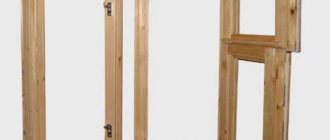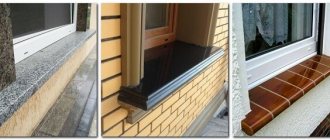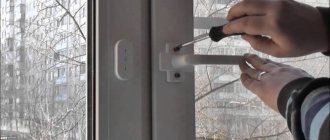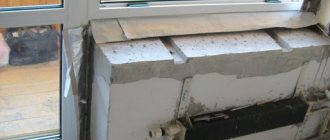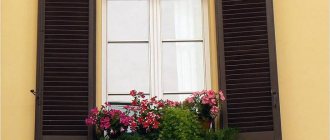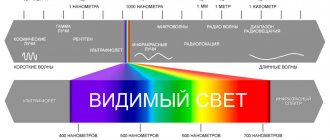Types of tides for windows
Any windows from the outside are equipped with a flashing - this is a special board mounted at the bottom of the window opening. It needs to allow rain or melt water to flow down it. This is probably why this part is sometimes called drainage.
Installing window sills is the final stage of proper installation
Window sills can be:
- Plastic.
- Metal; galvanized steel, coated: polyester;
- plastisol;
- metal paint.
If you install the window sill correctly, the wall will not be damp.
Currently, external concrete sills are almost never made. Or rather, they are made, but they are still covered with either plastic or metal. Concrete slopes can, of course, be whitewashed, and this was once done. But today this type of window decoration is very rare.
If we talk about the exotic, we can recall stone tides. They are made from polished granite or marble. They certainly look great, they don’t make any noise, and you can only break them with a sledgehammer. But their cost is not for every wallet.
Stone tides - look gorgeous
There is another interesting type of external window sills - from facade tiles. It works great with any window - both wooden and plastic. If your basement or the whole house is decorated with similar tiles, it will look very “on theme” on the windows. At the same time, the house looks like a single ensemble. Such slopes are made extremely simply: the tiles are cut so that they protrude 1 cm beyond the walls, and the desired slope is formed using a cement-sand mortar. The seams can be sealed with cement laitance, or a hydrophobic impregnation can be used. It’s just better to install such slopes before finishing the exterior walls.
Flashings from facade tiles - easy to do with your own hands
Although window slopes come in different materials, the vast majority of homeowners settle on two: plastic or metal. Each of them has its own pros and cons, and we’ll talk about them in more detail, as well as how to install window sills.
Step-by-step instructions for installing metal flashing
You can order a metal cast or make it yourself. We will tell you how to make the structure yourself below, and for example we will use a custom-made element. We will take the following indicators as the initial data: sheet steel casting, brick house with cement-sand plaster. The ebb tide is installed on plastered slopes.
To work, you will need metal scissors; if you don’t have them, you can use a grinder. In addition, you need to have a square, a marker (a pencil draws very poorly on metal), a tape measure, a screwdriver and self-tapping screws. If you need to prepare a cement-sand base, then prepare construction tools.
Step 1. Check the condition of the lower outer slope. If it does not meet the above conditions, then it will have to be plastered. Use ordinary cement-sand mortar or ceramic tile adhesive. Glue can only be used to level out small irregularities, and plaster mortar is used if the place is not prepared at all. During operation, ensure that the slope is within 10°.
Step 2. Take the drip dimensions to place your order. It should be several centimeters longer and wider than the slope.
Step 3. Measure the parameters of the slope and transfer them to low tide.
Next, there are two options for carrying out the work.
Prices for construction scissors for metal
Unfortunately, plastic flashings cannot be installed in such a reliable way. They are mounted end-to-end, the contact area is sealed with sealant. The ends are jammed with special inserts.
Step 4. Fix the bend of the ebb to the window frame with self-tapping screws. There are special recesses on the frames; make sure that the edges of the bend do not extend beyond them; the bend of the ebb should be located in the groove.
Remove the film from the low tide
Low tide installation. Final fitting and fitting
Putting the ebb in place
If the metal ebbs are more than one and a half meters long, then you can use liquid nails during installation, lubricate the surface of the base and then put the ebb in place.
Plastic: good or bad?
Plastic window tints are considered the most “quiet”. When raindrops fall on them, there is almost no sound. And they are also considered inexpensive, which is important if the budget is limited. Only unpainted galvanization is cheaper, but its appearance, after several years of use, is not very attractive, the paint holds very poorly.
What are the disadvantages of plastic moldings? The fact is that plastic loses its elasticity under the influence of ultraviolet radiation, becomes brittle, and can crack under load. And, even if there are no serious cracks, there are always microcracks. They form over time and become filled with dust. After a couple of years, the once snow-white plastic becomes grayish or has a yellow tint. Nothing can wash it off. If installing window sills every five to ten years doesn’t bother you, you can use them too.
Plastic ebbs are two planes connected by jumpers. You have to step very carefully
The following disadvantages of plastic moldings are flammability and significant thermal expansion. Plastic melts at high temperatures. If a cigarette butt gets on it, a hole will be provided. It may not happen that often, but there is a possibility.
Thermal expansion manifests itself if the installation of window sills on windows is done rigidly - the strip is fixed with self-tapping screws. Then, in hot weather, it “goes in waves” and bends. Afterwards, it usually returns to normal. In order not to worry about thermal expansion, oblong rather than round holes should first be made in the edge of the ebb, to which it will be attached. When tightening the screws, do not press down the plastic too much. Then, when changing the size, the plastic casting will not “behave”.
Plastic drip installation
The second point is to leave a thermal gap on the sides, which is filled with silicone waterproof sealant (for outdoor use). In this case, thermal expansion will not cause a “wave”. The plastic will simply expand a little, compressing the sealant, then return to normal. So installing plastic drip sills has its own nuances.
What can be non-standard?
In addition to standard sizes, products are also often made to order, with non-standard dimensions :
- When installing vents in the basement or dormer window blocks in the under-roof space, the length of the flashings can start from 300 mm.
- In case of installation of the product on a window profile, which is mounted flush with the facade line, the width can be no more than 50 mm, provided that a drip with a visor (top ebb) is installed at the level of the translucent structure lintel.
- When installing strip glazing, the length of the ebb can reach 5, 6, 8 or more meters. In such cases, the master resorts to joining several products with an overlap of 50 to 150 mm. In the case of composite or plastic products, a special docking unit with a folded edge is provided.
- If the outer wall of a building has a decorative protrusion made of vibro-pressed blocks, stucco or other protruding elements, the width of the strip for removing atmospheric moisture can reach 500 mm to ensure complete coverage of this architectural detail.
Before ordering a part with individual geometric characteristics, it is recommended to take measurements from the window opening, and then develop a detailed sketch with explication and detailing, which will serve as an accurate technical specification for the plant.
Metal - types and features
Metal window tintings are durable and there are no problems with them during operation. Installing metal window sills usually does not cause problems. Their disadvantage is “noisiness”. Raindrops can “knock” quite loud sounds out of metal. The problem is partially solved during installation - all cavities must be carefully filled with polyurethane foam. Any emptiness will act like a drum. So here we try to do everything as best as possible.
Metal window sills will be even quieter if foam rubber or any other sheet sound-absorbing material (for example, linotherm) is glued underneath. But it must withstand significant temperature changes - outdoor operation. These two techniques together will make the metal cast not too noisy.
When installing, do not leave voids and use vibration-damping, frost-resistant materials
As already mentioned, metal castings can be made of galvanized steel coated with polyester or plastisol. Galvanization with polyester - metal tiles are made from this material, so the technology has been proven. Such flashings are not too expensive, and you need to look for them in companies that produce or sell metal tiles or similar roofing materials.
Plastisol coating is a more expensive option, but it is thicker, making the metal less boomy. It is also interesting because the surface can be not only smooth, but also “leather-like”, embossed, etc. If your budget allows, try galvanized metal casting with plastisol coating. There are no negative reviews yet.
Correct installation
Another option for a “quiet” metal window sill is powder-coated aluminum. This metal itself is not so “ringing”, due to which the noise level is reduced. Everyone knows the advantages of operation, as well as the fact that the cost is not low. Installing window sills on aluminum windows is a good idea, but it is not so easy to find. Aluminum casting is not particularly popular, so you will most likely have to order it online. Especially if you live in a small city.
How to install ebb tides
Window installation is considered complete only when the installation of window sills is completed.
External sills (or, as usual, an external window sill) must be provided at each window. their main task is to drain water falling on the window. In this case, we mean snow or rain that flows down from the window.
Accordingly, external ebbs help protect the wall from water. In addition, external tides give the window a finished look. They are an integral element of both the window itself and the entire facade as a whole.
External tides are full of diversity. Today there are a huge number of them. They can be made of aluminum with a polyester or plastisol coating, from ordinary zinc-coated sheet or from plastic.
The choice depends only on what funds you have at your disposal.
If we talk about the configuration of the profile, then it must certainly have a bend corresponding to the window to which it will be attached. There should also be side bends and a bottom bend with a drip through which water will flow.
The width of the window sill is calculated so that it protrudes from the wall by 30 - 50 mm. The outward slope of the tide is required, because this ensures the free flow of water.
Installation of window sills
First, correctly installed external flashings should ensure that water cannot enter the wall surface.
Secondly, they must drain this water. And lastly, they must be firmly fixed, in other words, there must be no noise from gusts of wind and the sound of raindrops must be very muffled.
INSTALLATION DIAGRAM OF DIFTS
It is necessary to ensure that the tide goes under the window. On plastic windows there is a special profile at the bottom; the ebb is attached specifically to it. It is fixed using rivets and self-tapping screws.
The free space located under the ebb is filled with foam. This must be done to ensure thermal insulation, reliable fastening of the ebb itself, and absorption of noise from raindrops.
In order to prevent the polyurethane foam from raising the ebb, during the period of its hardening it is necessary to fix the ebb, pressing it well.
Another important nuance is the approach to external slopes. It is necessary to make sure that the ebb goes under the slopes - with side bends into the wall. Thanks to this, water will flow from the window and slopes at low tide.
In addition, this will serve as additional fastenings to the structure on the sides. To ensure this condition, it is recommended to install the sill before finishing the external window slopes.
The ebb, which is installed above the window, is called a visor. Typically, exposed elements are used for glazing winter gardens, loggias and the rest.
A profiled sheet of zinc-coated metal that does not have additional coatings is the most common and cheapest casting. Plastic and duralumin casts are used much less often.
If we talk about plastic, then it is considered not the best material for low tides. After all, under the influence of precipitation, the plastic cast will quickly lose its attractiveness.
How are duralumin casts made? Duralumin strips about a mm wide are bent and then painted using the powder coating method.
Polyester shimmers arch from already painted strips of zinc-coated steel. The paint is based on polyester. This coating does not crack or lose its color over time.
Visors and ebbs with a plastisol coating are quite resistant to temperature changes and precipitation. They have a cautious and neat appearance.
Deciding on the sizes
Metal castings can be sold in long strips - up to 6 meters long; you can find companies that will cut them into pieces of the length you need. The second option is good, since you don’t have to think about where to put the leftovers. The length of the window sill is determined by the width of the opening. The ebb board is usually made wider by 2-4 cm on each side. When preparing, the excess is cut off, leaving protrusions on both sides of the window opening. But you can cut it exactly to the width of the opening. It depends on the exterior wall finish and your desire/taste. In any case, if you order planks of a certain length, and do not cut them yourself, add a few centimeters - this way you can correct it if they are cut crooked.
The dimensions of the window tide are determined by the window opening
The depth of the tide on the window should be such that its edge protrudes a few centimeters. You don't need a protrusion that is too large - it can get in the way, but 4-5 cm is quite normal. In this case, the flowing water will not fall on the wall or under the foundation. With such a protrusion, moisture pours onto the blind area around the house, then goes into the storm drain.
Metal window sills have a larger range of sizes
When choosing a plastic casting, you may encounter difficulties. The narrowest ebb is 15 cm, and then the increase occurs in a certain step. Typically this step is 50 mm. So there may well be a situation - either too little or too much. You need to make a decision based on the situation - how critical is the ingress of water close to the foundation, how often do people walk along the windows. After evaluating these factors, you can choose a wider or narrower one.
What does the concept mean?
The window flashing size is the length, width and thickness of the structural element that drains water from the translucent block installed in the outer wall of the building.
, as well as comfort and safety during the operation of a living space, depend on the dimensions of the structure
The dimensions of the ebb are determined depending on the dimensions of the window structure, the thickness of the outer part of the slope, as well as the need to organize an overhang outside the plane of the building facade.
What does the size of the window product affect?
The size of the window block part under consideration affects the following parameters of the space being used and other structural elements:
- Number of stiffeners.
- The total area of raw materials used for the manufacture of a structural element in a factory, which determines the consumption of materials and the complexity of manufacturing.
- The presence of a drip for effective moisture removal.
- Depth of embedding an element into an external wall structure.
- The amount of overlap on the outer part of the window profile.
- The size of the projection beyond the plane of the façade.
- The type of fastening of a galvanized or plastic part to the profile or the lower edge of the slope of the facade cladding.
Thus, the correct selection of the ebb of a translucent structure is determined not only by aesthetic, but also by functional requirements.
Installation of ebb and flow on PVC profile windows
Regardless of the material - metal or plastic - the window sill is installed according to the same scheme. In the case of metal, gaskets are needed to reduce noise, but the general procedure remains the same.
There is a special protrusion in the frame profile for installing the ebb. The upper edge of the ebb goes under it. But this protrusion is only available if the PVC window was mounted on a stand (mounting) profile. Then installing the slope is a very simple matter. It must be cut to the width; if necessary, rubber or other material must be “planted” on the back side of the plank with universal glue for “silence”.
Correct installation of sills on PVC windows
Then all that remains is to insert the projection of the ebb into the groove, blow out the required amount of foam, and fix the ebb to the stand profile with three or more self-tapping screws. To prevent leaks from the sides, the areas where the ebb tide joins the window opening should be coated with silicone sealant. It’s better to take a transparent one - it will be less noticeable.
What if we play it safe?
To be on the safe side, before installing the ebb in the groove, you can apply the same silicone sealant. This will definitely prevent water from getting inside, even with a very strong wind directed at the window. The second “control shot” also concerns waterproofing. It is relevant for materials that are very susceptible to getting wet. For example, this is exactly what it is advisable to do when installing slopes on windows mounted in a frame house. In this case, before installing the window sill, a waterproofing tape is laid. It is advisable that the tape hangs over the wall - then even if some of the water gets on it, it will still end up outside the walls.
For those who like to play it safe
For waterproofing, you can use any rolled material that is suitable for outdoor use and can withstand frost and heat. Installing window sills in this way will prevent the area under the window from getting wet, even if the rain is very heavy.
If a plastic window is installed without a support profile
What to do if a plastic window is installed in violation of the technology and the groove is inaccessible? During installation, a plastic window is often leveled using triangular bars. After alignment, the window is attached to the opening, and the bars are left as is. If this is your case, you can secure the slope to these bars. If necessary, they can be trimmed. You just have to work carefully so as not to move them.
If everything is already installed and sealed, only the frame frame is available, you can screw the ebb to the frame. To seal, you can use a sealing gasket (rubber tape) and coat it with the best possible sealant. Additionally, you can screw some kind of flashing on top. Maybe he can save the situation a little.
Incorrectly attaching the sill to the window frame
But even with this approach, there is no certainty that water will not flow in. Maybe initially everything will be fine, but over time moisture will clearly get in. So, if possible, it is better to dismantle the incorrectly installed plastic window and install it again - according to the rules.
Installation technology
Correct tide position
In general, the technology for installing window sills or ebbs is simple and can be done with your own hands.
To illustrate the technique, let's look at how to install the most popular version of ebbs - from a steel sheet.
In the sequence of actions given below, we tried to take into account all the features of this process, but we must take into account that for each type of material there are separate technical nuances.
First of all, please note that the correct design of the ebb means that there are no open joints between the window sill and other finishing elements.
This rule should be observed when installing drainage of any type, including installing a PVC window sill with your own hands.
So, instructions for installing ebb tides:
- Assembly should begin with precise marking of the workpieces and determination of attachment points for decorative inserts (if any are used).
- The next stage is marking and drilling holes for the screws with which the ebb will be attached to the landing strip. To install the window sill correctly, it must be attached to the mounting profile.
- If the window opening is equipped with slopes, then it is necessary to consider the possibility of assembling the flashing in such a way that the side joints are also protected from direct water ingress.
- Next, you need to create an elastic cushion between the frame and the ebb. To do this, we recommend using polyurethane foam with a low expansion coefficient.
- Immediately after laying the foam, you can begin to fix the ebb in the working position, which can be done using self-tapping screws with closed heads.
accepts orders for the entire cycle of operations for installing windows in wooden houses, including the installation of window sills for windows of any design. You can clarify the terms of cooperation and order a visit from a specialist to assess the complexity of the work through any communication channel convenient for you, from those published on the “Contacts” page.
Calculate the cost of painting and insulating your home right now
Select types of work:
Select materials:
Features of tides for wooden windows
A groove must also be made in the frame of a wooden window for installation. In this case, there are no problems and installing window sills is no different. To be on the safe side, you can also lay a strip of waterproofing under the tide, tucking it into the same groove. When using a sealant, you need to look for one that has good adhesion (adhesion) to wood and metal or plastic - depends on the type of casting chosen.
External tides on wooden windows
If there is no ebb groove in a wooden window, you can make one yourself. The groove is not made too deep and wide. This may be a narrow cut into which only thin metal can be inserted. To prevent wood destruction, treat the cut with protective agents before installation. As a last resort, you can apply paint.
Tips for installing and repairing drainage systems on balconies and loggias
Nuances that will make drainage on the balcony as reliable as possible in operation.
- It is advisable to make the overhang of the upper visor larger than the overhang of the lower drain. In this case, raindrops and icicles will not fall on the cornice located below the window, which will reduce the noise level and extend its service life. It is important to take into account that the protrusion of the top visor should not be more than 10 cm. Otherwise, with a strong gust of wind, it may be bent and even torn out.
- Flashings made using professional equipment, that is, not a homemade product, are initially covered with a protective film. Its function is to maintain the integrity of the coating during transportation and installation of the element. Some craftsmen advise leaving the film after installation, since this, in their opinion, will allow the visor to maintain its appearance longer, and after removing the film, after a few years, get a completely new look for the product. Doing this is fundamentally wrong. Under the influence of sunlight, the film will begin to deform and may stick to the base so securely that it can no longer be removed.
The film must be removed immediately before or immediately after installation.
- Sound insulation of low tide on the balcony must be done using a vibration- and noise-absorbing coating, such as linotherm or vibroplast. The material is glued to the invisible side of the drain; it removes the lion's share of the noise that occurs during rain and hail.
Some manufacturers immediately equip their products with noise-absorbing material
- In the case of repairing the low tide on the balcony, it is necessary to completely dismantle the metal and clean the installation site of construction foam and sealant, and then reinstall the product according to the instructions given above. Targeted elimination of a defect, as a rule, only leads to a temporary solution to the problem.
- When using polyurethane foam, it is important to consider the degree of its expansion. To prevent the metal from deforming, during foaming, leave free space under the ebb and, if possible, load it with a weight tied to the window frame.
Semicircular or figured windows
Not all windows are linear. But what are the best sills for semicircular windows? All the same metals can save you. But just this time, the ideal option is copper shimmer. Copper is a ductile material and a slight curvature can be simply achieved by tapping it with a hammer.
You can make shaped products from copper
If copper is too expensive, there are factories that make radius castings to your measurements. Since this is an individual order, the cost of such a low tide will also be calculated in each specific case.
Radius flashings for windows in bay windows must be ordered
If there is a need to save money, you can make ebbs for figured bay windows from ordinary galvanized ebbs with a polymer coating. In this case, they are cut into pieces, with which you can create the desired bend.
Semi-circular ebbs from standard materials
With this method, one piece should overlap the adjacent one (by 3-5 cm) - this will make leakage less likely. To further reduce the likelihood of water ingress, a layer of sealant is applied to the joint.
Window sill design
The appearance of ebb tides is a purely individual matter, and since... Since they also play a decorative role, you can play with variations of shapes and colors. When bringing your design ideas to life, the main thing is not to overdo it. The ebb should harmoniously complement the window structure and be combined with the facade of the building. The ebb configuration includes both standard shapes and semicircular and shaped options.
Manufacturers also offer a large selection of colors from standard white and brown to the boldest and brightest shades. Thanks to the ability to make a metal cast with an imitation of a wooden surface, you can decorate a window made of wood or metal-plastic with a “wood-like” texture at no extra cost.
General requirements for geometric parameters of ebb tides
Before choosing an element, you should study the basic requirements and technical dimensions of the future product:
- The width of the external window sill depends on the width of the opening. To these dimensions you should add 3-4 cm per protrusion. It is also necessary to take into account the small angle of inclination of the tide. The minimum width of the product is 90 mm;
- to measure the length, measure the distance between the edges of the window opening from the outside. Add 3-4 cm on each side to the measurements obtained. The finished product should be 6-8 cm greater than the distance between the edges on the outside of the window opening;
- It is important to choose the correct configuration of the finished structure. The external window sill for a frame house will differ from the sill in a building built of brick or panel;
- The colors of the sills for windows and plinths should be combined with the external design of the window opening. For white windows, the external window sill should also be white. If the frames are made in a different color scheme, the window sill should be painted in a similar color or a tone darker.
Window sill configuration
What is low tide and why is it needed?
The first thing we need to find out is what slopes on windows are and why they are needed on our facade. It's simple, the low tide is the window sill on the outside of the window. It doesn’t just give the glass unit a finished look. This element has an important practical function - protecting the façade covering under the window from rain and snow. It is this simple device that stands between the window frame and the wall.
The safety of the outer wall depends on how well the ebb is installed.
The ebb is placed very tightly against the wall and all joints are sealed. If you are not careful enough during the installation process, water will get into the joints, leak into the house and flood the facade.
It is impossible not to note the decorative function of this detail. It is the ebb that hides all the frame fastenings and the mounting foam that fills the gaps between the structure and the wall. With low tide, any window from the outside looks neat.
Can I make it myself?
Typically, a metal drip is made from a long factory-made plate, the edges of which are already bent at the top (toward the window) and bottom (drip edge). You just need to cut the required piece from such a blank and secure it in the window opening. Plastic analogues are most often immediately sold ready-made in the required sizes with all the necessary bends. This window sill just needs to be fixed in place.
But you can make the low tide yourself from a sheet of tin. Here you will need metal scissors and pliers. It is enough to calculate the required dimensions, mark the metal with a pencil and cut off the required fragment.
If you bend the edges with pliers, the bend often turns out crooked. It is better to prepare in advance a small auxiliary device from three wooden planks connected to each other with bolts or self-tapping screws. This tool is made so that between the lower and upper boards there is space for the tin insert. That is, the metal is brought inward, and the edge is evenly bent along the entire length, and not in separate sections.
Features of low tide installation
Why is it important to know?
If you have complete information about the existing standard sizes of ebbs for window units, the consumer receives a number of advantages:
The ability to accurately calculate the embedding of a product in a quarter, or in the seams of facing masonry made of other materials.- A correctly calculated overhang prevents the facade from getting wet, which contributes to its safety and durability.
- Standard overall dimensions of drip sills, regardless of materials, are cheaper than parts ordered according to individual specifications.
- The consumer gets the opportunity to accurately determine the quantity and dimensions of fasteners for products.
- Accurate knowledge of the standard dimensions allows you to quickly hand over the finished building to the state commission, without the need to appoint additional examinations and approvals.
In case of erroneous determination of the size of the ebb, trimming will be required, or an overpayment will be required for the manufacture of a part with individual geometric characteristics.
How to choose?
To choose the right size of galvanized or polymer sill for a window, you need to take into account a number of nuances :
- The width of the outer part of the slope after installing the window unit.
- The width of the opening to be filled with a translucent element.
- Overhang dimensions for complete removal of atmospheric moisture, taking into account all protrusions on the façade of the structure.
- The thickness of the product, which determines its load-bearing capacity when calculating ice and snow loads.
- The type of fastening, insulation, and filling of the seam between the ebb and flow of the building structure.
- The optimal dimensions of the product in question are those in which its length is 100–200 mm greater than the width of the window opening, its width provides a minimum overhang of 50 mm, and its thickness allows it to withstand up to 30 kg of payload per 1 linear meter without destruction, tearing out fasteners or material deformation.
When choosing and purchasing a sill with optimal dimensions, the product will exactly fit the fitting size of the window unit, which will allow the entire structure to be used throughout the service life of the translucent element, usually at least 25 years.
